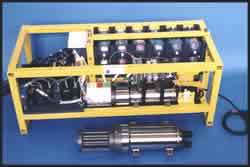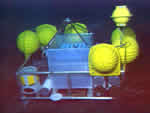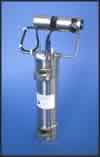| |
SUAVE
 SUAVE,
or a System Used to Assess Vented Emissions,
provides continuous, in-situ analysis of hydrothermal chemical species
such as iron, manganese and hydrogen sulfide based on principals of flow
analysis and colorimetric detection. In addition to chemical components,
SUAVE is equipped to accept signals from an array of auxiliary sensors
that include state of the art CTD sensors, optical sensors, thermisters,
or any other sensor with output between 0 and 5 vdc. SUAVE is extremely
versatile and can be mounted on a wide variety of platforms for sampling
during profiles or transects, or deployed for short term monitoring applications. SUAVE,
or a System Used to Assess Vented Emissions,
provides continuous, in-situ analysis of hydrothermal chemical species
such as iron, manganese and hydrogen sulfide based on principals of flow
analysis and colorimetric detection. In addition to chemical components,
SUAVE is equipped to accept signals from an array of auxiliary sensors
that include state of the art CTD sensors, optical sensors, thermisters,
or any other sensor with output between 0 and 5 vdc. SUAVE is extremely
versatile and can be mounted on a wide variety of platforms for sampling
during profiles or transects, or deployed for short term monitoring applications.
NeMO
Net RAS
 The
RAS (Remote Access Sampler) is capable of collecting 48 vent fluid and
particle samples in a time-series. The system is a McLane 48-500 Remote
Access Sampler, with hardware and software enhancements done at PMEL.
Temperature measurements are made every 10 minutes. The sampler is programmed
to take a water/particle sample once per week and collect chemical sensor
data (pH and H2S) twice per week. The system can also be sent a command
at any time via satellite to collect samples or send back temperature
data. This interactivity will allow us to take samples quickly and at
critical times, for example in response to any seismic or volcanic activity,
long before any ship could get to the site. By having these instruments
in place we hope to learn more about the dynamic early stages of such
events. The
RAS (Remote Access Sampler) is capable of collecting 48 vent fluid and
particle samples in a time-series. The system is a McLane 48-500 Remote
Access Sampler, with hardware and software enhancements done at PMEL.
Temperature measurements are made every 10 minutes. The sampler is programmed
to take a water/particle sample once per week and collect chemical sensor
data (pH and H2S) twice per week. The system can also be sent a command
at any time via satellite to collect samples or send back temperature
data. This interactivity will allow us to take samples quickly and at
critical times, for example in response to any seismic or volcanic activity,
long before any ship could get to the site. By having these instruments
in place we hope to learn more about the dynamic early stages of such
events.
MAPR
 The
PMEL MAPR was designed to be a relatively inexpensive, lightweight yet
rugged, simple to use self-contained instrument for recording temperature,
pressure, optical, and conductivity data on a wide variety of deployments. The
PMEL MAPR was designed to be a relatively inexpensive, lightweight yet
rugged, simple to use self-contained instrument for recording temperature,
pressure, optical, and conductivity data on a wide variety of deployments.
|
|

